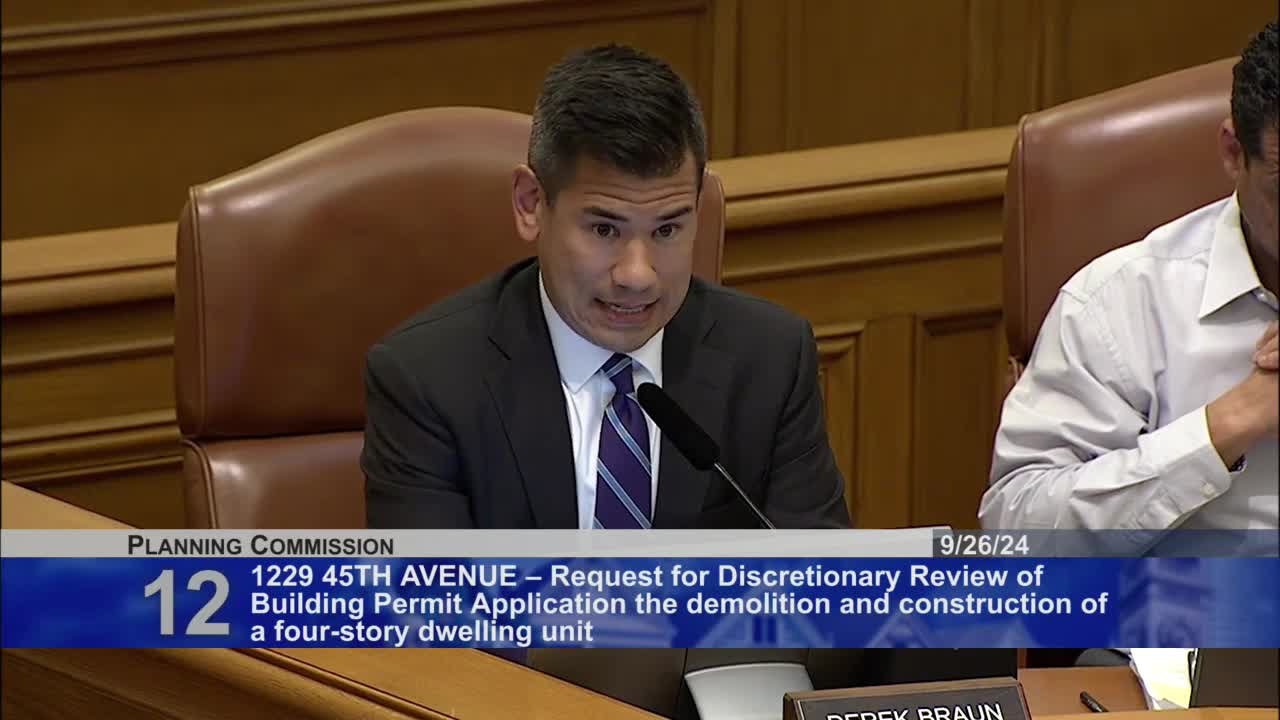Commissioners clash over controversial housing project approval
September 26, 2024 | San Francisco County, California
This article was created by AI summarizing key points discussed. AI makes mistakes, so for full details and context, please refer to the video of the full meeting. Please report any errors so we can fix them. Report an error »

In a recent government meeting, city commissioners engaged in a detailed discussion regarding a proposed project that has sparked debate over its classification as an accessory dwelling unit (ADU) versus a single-family home. Commissioner Williams expressed concerns, stating that the structure in question does not resemble a typical ADU and questioned the implications of categorizing it as such. He emphasized the need to understand the differences between building a single-family home and an ADU, highlighting the potential ramifications for future developments.
Mister Winslow, a representative from the planning department, clarified that the ADU program is designed to increase density on zoning lots, allowing for additional units on properties. He noted that while the local program does not impose strict size limitations, the classification of a structure as an ADU is contingent upon it being an accessory to another unit on the lot. He also mentioned ongoing legislative efforts that could enable more units to be built on the property in question.
Concerns were raised about the condition of existing structures on the site, with some commissioners questioning their habitability and potential health hazards. Commissioner Moore pointed out that the planning department typically does not assess the livability of existing conditions during project reviews, which raised further questions about the implications of approving the project without certainty regarding the state of these structures.
The discussion also touched on the impact of the proposed project on neighboring properties, particularly regarding light access for residents. Commissioners acknowledged the challenges posed by the narrow lot lines typical in San Francisco and discussed potential solutions to mitigate the impact on light for adjacent homes.
Ultimately, the commissioners recognized the necessity of increasing housing density in the city but grappled with the complexities of the project’s classification and its implications for both current and future developments. The meeting concluded with a motion to approve the project, pending further deliberation on the concerns raised.
Mister Winslow, a representative from the planning department, clarified that the ADU program is designed to increase density on zoning lots, allowing for additional units on properties. He noted that while the local program does not impose strict size limitations, the classification of a structure as an ADU is contingent upon it being an accessory to another unit on the lot. He also mentioned ongoing legislative efforts that could enable more units to be built on the property in question.
Concerns were raised about the condition of existing structures on the site, with some commissioners questioning their habitability and potential health hazards. Commissioner Moore pointed out that the planning department typically does not assess the livability of existing conditions during project reviews, which raised further questions about the implications of approving the project without certainty regarding the state of these structures.
The discussion also touched on the impact of the proposed project on neighboring properties, particularly regarding light access for residents. Commissioners acknowledged the challenges posed by the narrow lot lines typical in San Francisco and discussed potential solutions to mitigate the impact on light for adjacent homes.
Ultimately, the commissioners recognized the necessity of increasing housing density in the city but grappled with the complexities of the project’s classification and its implications for both current and future developments. The meeting concluded with a motion to approve the project, pending further deliberation on the concerns raised.
View full meeting
This article is based on a recent meeting—watch the full video and explore the complete transcript for deeper insights into the discussion.
View full meeting
